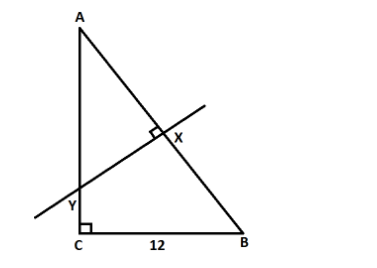Answer
390.6k+ views
Hint: We will use a three step process to solve this problem. In the first step, we will find the ratio of area of triangle AYX to area of triangle ABC by using the given ratio of the area of quadrilateral BXYC to the area of triangle ABC. In the second step, we will use the area of similar triangle theorems. And finally, we will use the Pythagoras theorem to get our final answer.
Complete step-by-step answer:
We can draw the diagram of the given representation as shown in the figure below.

It is given that the ratio of the area of quadrilateral BXYC to the area of triangle ABC is $13:18$.
It is clear from the diagram that
\[Area{\text{ }}of{\text{ }}ABC = Area{\text{ }}of{\text{ }}AYX + Area{\text{ }}of{\text{ }}BXYC\]
Dividing both the sides by Area of ABC
\[ \Rightarrow 1 = \dfrac{{Area{\text{ }}of{\text{ }}AYX}}{{Area{\text{ }}of{\text{ }}ABC}} + \dfrac{{{\text{ }}Area{\text{ }}of{\text{ }}BXYC}}{{Area{\text{ }}of{\text{ }}ABC}}\]
\[ \Rightarrow 1 = \dfrac{{Area{\text{ }}of{\text{ }}AYX}}{{Area{\text{ }}of{\text{ }}ABC}} + \dfrac{{13}}{{18}}\]
\[ \Rightarrow \dfrac{{Area{\text{ }}of{\text{ }}AYX}}{{Area{\text{ }}of{\text{ }}ABC}} = 1 - \dfrac{{13}}{{18}}\]
\[ \Rightarrow \dfrac{{Area{\text{ }}of{\text{ }}AYX}}{{Area{\text{ }}of{\text{ }}ABC}} = \dfrac{5}{{18}}\]
From the diagram, we can say that ABC and AYX are similar triangles.
As per the theorem of area of similar triangles, the ratio of the areas of two similar triangles is the same as the ratio of the square of their sides.
\[ \Rightarrow \dfrac{{A{X^2}}}{{A{C^2}}} = \dfrac{5}{{18}}\]
As XY is the perpendicular bisector of AB, $AX = \dfrac{{AB}}{2}$
\[
\Rightarrow \dfrac{{{{\left( {\dfrac{{AB}}{2}} \right)}^2}}}{{A{C^2}}} = \dfrac{5}{{18}} \\
\Rightarrow \dfrac{{A{B^2}}}{{4 \times A{C^2}}} = \dfrac{5}{{18}} \;
\]
Now, in right angle triangle ABC with $\angle BCA = 90^\circ $, as per the Pythagoras law,
$A{B^2} = A{C^2} + B{C^2} = A{C^2} + {12^2}$
\[
\Rightarrow \dfrac{{A{C^2} + {{12}^2}}}{{4 \times A{C^2}}} = \dfrac{5}{{18}} \\
\Rightarrow 18A{C^2} + \left( {18 \times {{12}^2}} \right) = 20A{C^2} \\
\Rightarrow 2A{C^2} = 18 \times {12^2} \\
\Rightarrow A{C^2} = 9 \times {12^2} \\
\Rightarrow A{C^2} = {3^2} \times {12^2} \\
\Rightarrow AC = 36 \;
\]
Thus, the length of AC is 36.
So, the correct answer is “36”.
Note: In this type of question, we need to analyze the given data and think of useful theorems which can be applied to get to the answers easily. For example, here, we have applied two theorems. First, area of similar triangle theorem and then Pythagoras theorem to determine our final answer, the length of AC.
Complete step-by-step answer:
We can draw the diagram of the given representation as shown in the figure below.

It is given that the ratio of the area of quadrilateral BXYC to the area of triangle ABC is $13:18$.
It is clear from the diagram that
\[Area{\text{ }}of{\text{ }}ABC = Area{\text{ }}of{\text{ }}AYX + Area{\text{ }}of{\text{ }}BXYC\]
Dividing both the sides by Area of ABC
\[ \Rightarrow 1 = \dfrac{{Area{\text{ }}of{\text{ }}AYX}}{{Area{\text{ }}of{\text{ }}ABC}} + \dfrac{{{\text{ }}Area{\text{ }}of{\text{ }}BXYC}}{{Area{\text{ }}of{\text{ }}ABC}}\]
\[ \Rightarrow 1 = \dfrac{{Area{\text{ }}of{\text{ }}AYX}}{{Area{\text{ }}of{\text{ }}ABC}} + \dfrac{{13}}{{18}}\]
\[ \Rightarrow \dfrac{{Area{\text{ }}of{\text{ }}AYX}}{{Area{\text{ }}of{\text{ }}ABC}} = 1 - \dfrac{{13}}{{18}}\]
\[ \Rightarrow \dfrac{{Area{\text{ }}of{\text{ }}AYX}}{{Area{\text{ }}of{\text{ }}ABC}} = \dfrac{5}{{18}}\]
From the diagram, we can say that ABC and AYX are similar triangles.
As per the theorem of area of similar triangles, the ratio of the areas of two similar triangles is the same as the ratio of the square of their sides.
\[ \Rightarrow \dfrac{{A{X^2}}}{{A{C^2}}} = \dfrac{5}{{18}}\]
As XY is the perpendicular bisector of AB, $AX = \dfrac{{AB}}{2}$
\[
\Rightarrow \dfrac{{{{\left( {\dfrac{{AB}}{2}} \right)}^2}}}{{A{C^2}}} = \dfrac{5}{{18}} \\
\Rightarrow \dfrac{{A{B^2}}}{{4 \times A{C^2}}} = \dfrac{5}{{18}} \;
\]
Now, in right angle triangle ABC with $\angle BCA = 90^\circ $, as per the Pythagoras law,
$A{B^2} = A{C^2} + B{C^2} = A{C^2} + {12^2}$
\[
\Rightarrow \dfrac{{A{C^2} + {{12}^2}}}{{4 \times A{C^2}}} = \dfrac{5}{{18}} \\
\Rightarrow 18A{C^2} + \left( {18 \times {{12}^2}} \right) = 20A{C^2} \\
\Rightarrow 2A{C^2} = 18 \times {12^2} \\
\Rightarrow A{C^2} = 9 \times {12^2} \\
\Rightarrow A{C^2} = {3^2} \times {12^2} \\
\Rightarrow AC = 36 \;
\]
Thus, the length of AC is 36.
So, the correct answer is “36”.
Note: In this type of question, we need to analyze the given data and think of useful theorems which can be applied to get to the answers easily. For example, here, we have applied two theorems. First, area of similar triangle theorem and then Pythagoras theorem to determine our final answer, the length of AC.
Recently Updated Pages
Why Are Noble Gases NonReactive class 11 chemistry CBSE

Let X and Y be the sets of all positive divisors of class 11 maths CBSE

Let x and y be 2 real numbers which satisfy the equations class 11 maths CBSE

Let x 4log 2sqrt 9k 1 + 7 and y dfrac132log 2sqrt5 class 11 maths CBSE

Let x22ax+b20 and x22bx+a20 be two equations Then the class 11 maths CBSE

Let x1x2xn be in an AP of x1 + x4 + x9 + x11 + x20-class-11-maths-CBSE

Trending doubts
Which are the Top 10 Largest Countries of the World?

Fill the blanks with the suitable prepositions 1 The class 9 english CBSE

Difference between Prokaryotic cell and Eukaryotic class 11 biology CBSE

Give 10 examples for herbs , shrubs , climbers , creepers

Difference Between Plant Cell and Animal Cell

Change the following sentences into negative and interrogative class 10 english CBSE

Write a letter to the principal requesting him to grant class 10 english CBSE

Name 10 Living and Non living things class 9 biology CBSE

Fill the blanks with proper collective nouns 1 A of class 10 english CBSE



